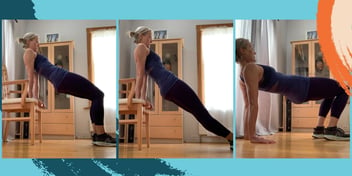DIASTASIS RECTI SERIES PART 1
Kim Raubenheimer is a certified Nutritionist and a trainer specializing in Diastasis Recti. After self-diagnosing her own diastasis in 2008, she went on a journey to discover everything she could about the condition. She continues to coach individuals - especially busy moms - and was eager to share her knowledge with Levelle Nutrition.


I've fielded a lot of questions during my time as a health and fitness coach:
- Why does it look like a loaf of bread is coming out of my belly when I lift my head and shoulders off the ground?
- Why do I look 4 months pregnant; even though I am not?
- Why do I feel like my organs are out of place?
- Why do I have back and hip pain?
- Why do I have GI issues?
My personal journey started with a question, too. One I posed to my obstetrician during my second pregnancy:
“What is that bulge above and beyond my pregnant belly? It looks like a scene from 'Alien'!”
“It’s a normal part of pregnancy and will go back to normal post-delivery,” my OB said.
OK, I thought, file that away for “must research.”
My healthy baby boy was born, and I went back to teaching and running two weeks postpartum. In hindsight, a bit too soon. Every time I ran, I could barely walk the next day due to hip pain. Leaking had started with impact. I ran a road race at three weeks postpartum and peed my pants all the way to the finish line.
Something was not right.
I had to figure it out. I put on my fact-finding hat, self-diagnosed and figured out it was diastasis recti.
What Is Diastasis Recti?
With diastasis recti, the connective tissue in the middle of the abdomen is stretched thin, allowing the outer abdominal muscles – the recti or “six pack” muscles – to separate. This separation can occur above or below the belly button, or all the way from the sternum to the pubic bone (see the image below).
IMAGE CREDIT: SHUTTERSTOCK 1254911524
The weak connective tissue and resulting separation can fail to protect your organs and/or sufficiently support your back. If the separation is large enough, the organs will protrude, creating that bulge in the belly. Accompanying symptoms vary, and can include GI issues, back pain, hip pain, or urinary leaking. You can also be more prone to hernias with a diastasis.
What Causes Diastasis Recti?
A diastasis can be caused by the continuous forward forceful pressure on the weak part (belly button) of the connective tissue of the rectus abdominis, which is why it’s most common in pregnant and postpartum women. However, diastasis recti doesn’t discriminate: men and nonpregnant women can develop one too.
The intra-abdominal pressure can be caused by a growing uterus, improper lifting, or improper breathing — especially upon exertion. It can also be due to over-toned muscles, such as with oblique dominance. I, for example, am an upper ab gripper and was constantly holding my breath during exertion and stress, especially in my 20s.
Any exertion without proper form and breathing – including lifting, twisting, sitting, standing, having a bowel movement, sneezing, coughing, or even blowing your nose – can contribute to a diastasis.
How Can I Check for Diastasis Recti?
Diastasis Recti is measured in terms of finger width; a two-finger width or more is considered a DR. To determine the severity of your diastasis you need to know two things: 1. The distance between the two muscles. The wider the diastasis the longer it takes to close it. 2. The condition of the connective tissue. The further your fingers go into your belly, the weaker the connective tissue. The weaker the connective tissue the longer it takes to heal. As the connective tissue becomes shallower, the muscles come together.
If you want to attempt a self-check before being seen by a professional, take a look at this helpful video by Dr. Sarah Duvall.
Here is a simple test.
Doing a self-check can be complicated for beginners and it's easy to get a false reading (I did! I thought my diastasis was only two fingers, but when I got it assessed by an expert, it turned out to be actually 4 fingers, all the way from my sternum down to my pubic bone.) For clarity, I walk through how to do a self-check in the video below.
What Can I Do About Diastasis Recti?
If you think you have a diastasis, contact your OB/PT — especially if you have symptoms. Meanwhile, back off to easier levels of any exercise that is giving you trouble. To learn about proper posture, alignment and breathing techniques, check out the second blog in the Diastasis Recti series: Foundational Focus for Diastasis Recti. If you want to learn about safe exercises to do to help fix a diastasis, take a look at Rectifying a Diastasis Recti with Exercise.




.jpg)




